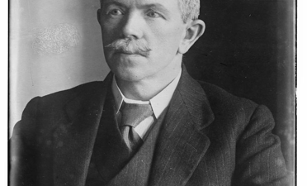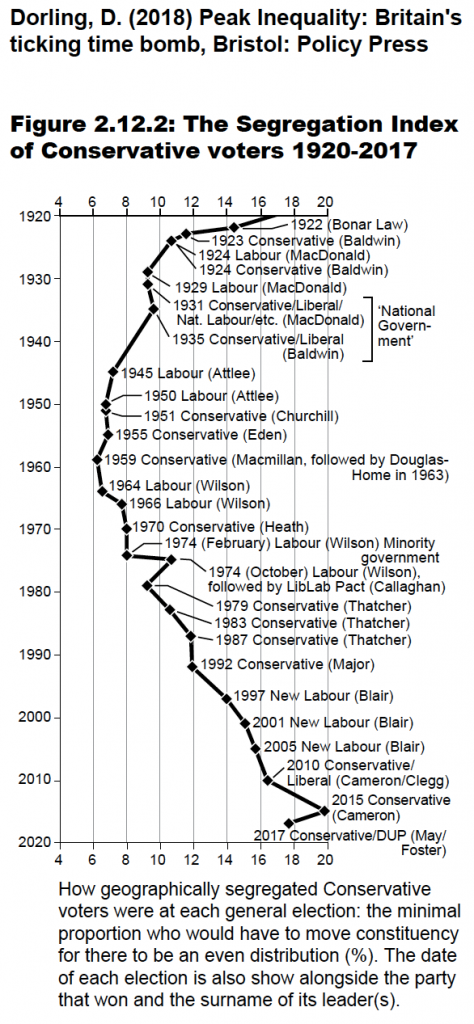What did the elections of 1922 and 2017 have in common?

You probably don’t know about the 1922 general election. It was the ‘breakthrough election’. The Conservatives under Andrew Bonar Law won; but Labour moved from fifth place in 1918 to third place, and increased the number of seats they held from 57 in 1918 to 142 1922.
Labour were led by John Robert Clynes. Self-educated, he was critical of how the government had treated voters in Ireland, and later opposed Ramsay MacDonald’s support for austerity during the depression years. Clynes was ousted by MacDonald as leader of the Party within a month of that election. MacDonald would go on to form a National government in 1931 with 473 Conservative MPs.

Image: J.R. Clynes. Source: Library of Congress.
There was enormous division and strife within the Labour Party in the 1920s. These were years in which inequalities were actually falling in society, but very few people knew that they were. Income inequalities had peaked in 1918. They fell more between 1918 and 1938 than in the next forty years.
Britain was changing rapidly in the 1920s. Hugh Dalton, who later became Chancellor of the Exchequer, studied the beginning of the income inequality fall while a student at the LSE. He was one of the few who measured what was happening.
Others wrote novels and plays where the backdrop was the fall in inequalities in the 1920s, but the two best remembered were not published until 1945. Brideshead Revisited and An Inspector Calls were both, in their very different ways, about unsustainable inequalities.
The 1922 election was not just notable for how well Labour did, but for it being the first election in many decades in which the geographical distribution of votes became more equal. In particular, the Conservatives lost more votes where they had been more popular in 1918. The graph accompanying this short article shows the trend (see note beneath the graph).

This figure was first drawn in 2006 and has be updated ever since by it’s author (although the data point for the 2019 election needs adding!)
From 1922 onwards, with just the smallest of blips in 1935, Conservative voters would become less and less geographically segregated in Britain. Irrespective of the ups and downs (in terms of which party won each election) at each subsequent election it became harder to predict how someone would vote simply by knowing which constituency they lived in. That trend continued onwards to 1959, and after then voter segregation hardly rose at all until the 1970s. However, after the election of Margaret Thatcher’s government in 1979 it rose at every successive election through to 2015.
None of this would be relevant today if it were not for one particularly uncanny contemporary parallel with the past. The first election after 1922, in which geographical segregation fell, was that held in 2017. The 2017 election was remarkable, not just for the damage done to Theresa May’s majority, but because the tide had been turned in the very long term trend. It may be too early to say – but something quite remarkable began in 2017 and it appears to be continuing. For the first time in almost one hundred years, geographical inequalities in voting between constituencies began to fall again.
In 2017, Labour picked up more votes in areas where it had had the least support in 2015, and fewer votes where it already piled them high. Although this might not be the best strategy to win elections, it was a sign of a shift. Voters in the South of England, in what had been solidly Conservative seats, began more often to vote Labour. Other voters, in seats where Labour had often taken support for granted, no longer voted Labour quite so enthusiastically.
In 2017 Labour increased its seat count to 262 (up 30), and its total vote to 12.9 million; but what was much less noticed was the shift in the geographical distribution of Labour and the Conservative voters. That shift accelerated in 2019. Again the shift was not much noticed. It was obscured by talk of a ‘red wall’ having been broken. Few people noticed that the Conservative share of the vote in all of South East England fell between 2017 and 2019. The Tory share in London also fell in 2019. However, commentators were much more interested in the loss of 60 Labour seats. They rarely pointed out that the number of Labour votes falling to 10.3 million meant Labour still polled more votes in 2019 than it had in 2005, 2010, or 2015. The fall in Labour voting was mainly due to lower turnout in 2019 as compared to 2017.
What parallels can we draw with the 1920s? Jeremy Corbyn was a very different MP to John Clynes, although both opposed the austerity of their times and both were attacked from within shortly after the two great shifts in voting. Inequalities, if measured by the take of the top 1%, were very high in both the 1920s and 2020s.
There are a few tentative signs that income and wealth are now falling, if only slightly. State pensions and many benefits have risen by inflation. This is not enough, as inflation for the poor is higher, but it is a larger relative increase than most people in employment are receiving. Many pay deals are being struck now that are progressive. Bosses offer higher increases for lower paid workers in an attempt to shame unions into agreeing a below inflation deal. As I write, house prices have fallen for many months. These falls are large when compared to inflation and may be the beginning of a redistribution of wealth.
I first drew the graph shown here in 2006. I have been waiting a long time for the shift. I may be too optimistic. But when it last shifted in 1922 that was not because Labour came to power that year, it was because inequalities had to fall. Steep social divides also began to fall, imperceptibly at first, under governments led by Conservatives who believed in the old ways, in hierarchy, and in people knowing their place. The divides fell while Labour were in disarray, at war internally. People fought for the divides to fall, but they did so successfully without the need for particularly inspirational Prime Ministers.
For a PDF of this article and where this was originally published click here.